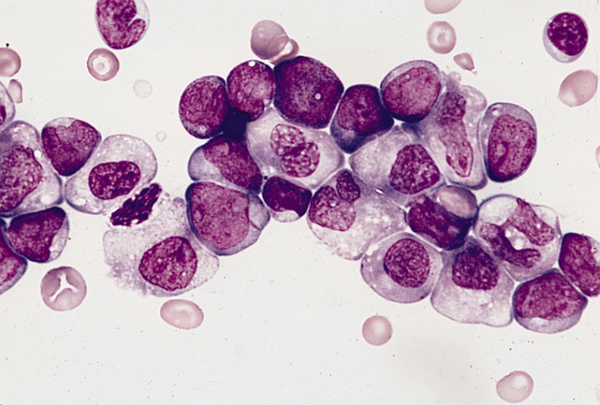A new microRNA signaling route has been identified by cancer researchers at the University of Cincinnati. The finding could help drug developers identify new targets for the aggressive blood cancer, acute myeloid leukemia (AML).
AML occurs when immature blast cells are produced in the bone marrow, but do not mature into functional white blood cells. The most common type of acute leukemia, patients with AML have a weakened immune system and are unable to fight off infections.
According to Dr. Jianjun Chen, associate professor in the Department of Cancer Biology at the UC College of Medicine, microRNAs play a key role in cancer development. “MicroRNAs make up a class of small, non-coding internal RNAs that control a gene’s job, or expression, by directing their target messaging RNAs, or mRNAs, to inhibit or stop. Cellular organisms use mRNA to convey genetic information.”
“Previous research has shown that microRNA miR-22 is linked to breast cancer and other blood disorders which sometimes turn into AML, but we found in this study that it could be an essential anti-tumor gate keeper in AML when it is down-regulated, meaning its function is minimized,” said Chen. After studying miR-22, the researchers discovered that it had a direct effect on AML development.
“When we forced miR-22 expression, we saw difficulty in leukemia cells developing, growing and thriving,” said Chen. “miR-22 targets multiple cancer causing genes (CRTC1, FLT3 and MYCBP) and blocks certain pathways (CREB and MYC). The down-regulation, or decreased output, of miR-22 in AML is caused by the loss of the number of DNA being copied and/or stopping their expression through a pathway, called TET1/GFI1/EZH2/SIN3A. Also, nanoparticles carrying miR-22 DNA oligonucleotides (short nucleic acid molecules) prevented leukemia advancement.”
According to Chen, in mammals the ten-eleven translocation proteins (TET1/2/3) are regulators of gene expression. Chen and his team used bone marrow transplant samples and animal models to perform their research, the results of which were published in the journal, Nature Communications.
“We recently reported that TET1 plays an essential cancer generating role in certain AML where it activates expression of homeobox genes, which are a large family of similar genes that direct the formation of many body structures during early embryonic development,” said Chen. “However, it is unknown whether TET1 can also function as a repressor for cellular function in cancer, and its role in microRNA expression has rarely been studied.”
As AML is both a common and often fatal cancer, the researchers say their findings regarding the microRNA pathway could be crucial to identifying new therapeutic targets. Further studies will hopefully allow researchers to better understand the pathogenesis of the disease, as well as how AML might respond to treatment.
“The majority of patients with ALM usually don’t survive longer than five years, even with chemotherapy, which is why the development of new effective therapies based on the underlying mechanisms of the disease is so important,” said Chen. “Our study uncovers a previously unappreciated signaling pathway, and provides new insights into genetic mechanisms causing and progressing AML and also highlights the clinical potential of miR-22-based AML therapy. More research on this pathway and ways to target it are necessary.”












Join or login to leave a comment
JOIN LOGIN